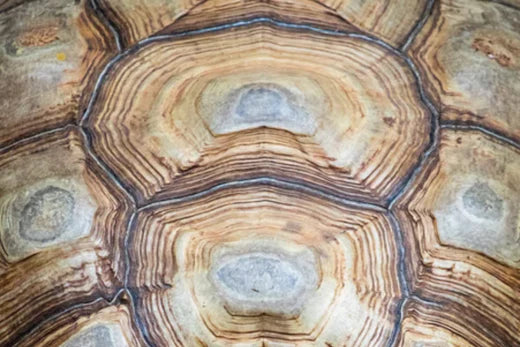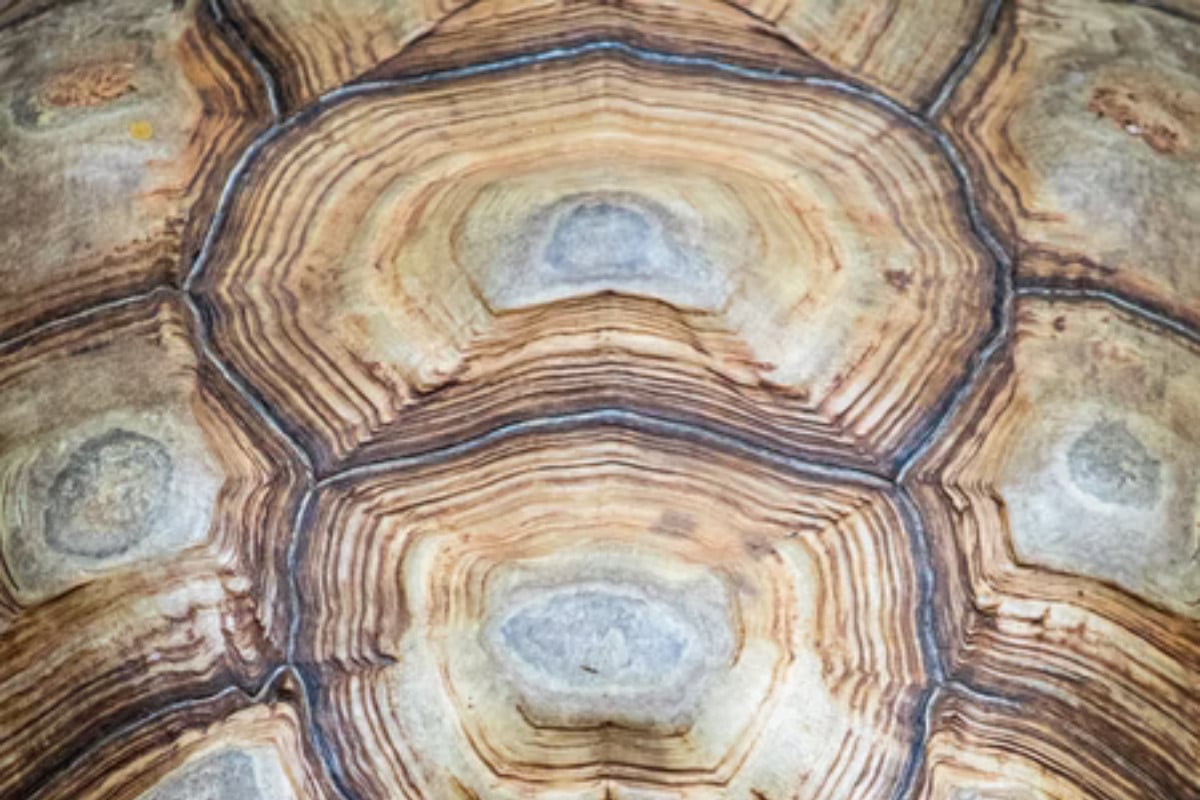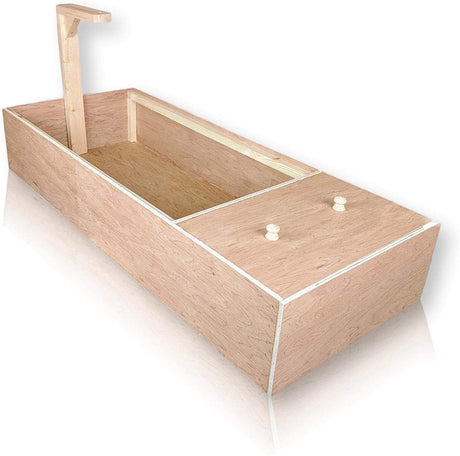What is Tortoise Shell Rot?
Shell rot refers to an infection of your tortoise’s shell. It can also be called ulcerative shell disease and any shelled reptile, including tortoises, terrapins and turtles, can all suffer from it.
It can occur on both the carapace (top) or the plastron (bottom) of the shell and can be seen in many different forms, and can be caused by many different things.
What Causes Shell Rot?
There can be several causes of shell rot, all resulting in different types of rot that manifest in different ways.
Unclean Environment
If your tortoise’s enclosure is unhygienic, then bacteria is more likely to grow which is one of the leading causes of shell rot in tortoises.
Substrates can quickly become mouldy if you do not clean out faeces regularly enough and then your tortoise’s enclosure can soon become a breeding ground for bacteria. Most tortoises love to soak in their water dishes but it is also common for them to defecate here, too, which can be another source of bacteria if the bowls are not cleared daily and they are not provided with fresh water on a regular basis.
The bacteria that grows in the dirty water dishes and mouldy substrate can infect the blood vessels through small abrasions in the shell that may not be an issue if your tortoise’s environment was clean.
Shell Damage
Damage to a tortoise’s shell can increase their risk of getting shell rot. Their shells can become damaged or weakened by many different things which are then susceptible to a bacterial infection.
- If their environment is too dry it can cause your tortoise to become dehydrated and their shell can crack
- Without the right conditions, your tortoise can develop metabolic bone disease which will cause your tortoise’s shell to become weak and more susceptible to damage
- If you have more than one tortoise in an enclosure, they can damage each other's shell if they become aggressive and territorial
- Sharp objects or edges in the enclosure can cause real damage so always check their homes for anything that could hurt them
If your tortoise’s shell is damaged then it leaves their blood stream exposed, and pathogens gaining access to your tortoise’s blood stream can be fatal. Make sure to check for any damage and treat it immediately.

Incorrect Environment
As we mentioned just now, if their environment is too dry then a tortoise shell can crack and become infected. However, on the other hand, if the environment is too moist then your tortoise will not be able to dry out properly which can lead to a soft shell and increased risk of infection. Not only is the surrounding temperature and humidity very important, but the incorrect substrate humidity can be just as vital; a damp and warm environment is the perfect breeding ground for unwelcome bacteria but a dry one can be dangerously dehydrating!
Make sure that you are using the providing the correct conditions for your tortoise; this includes substrate, humidity, temperature and furnishings; and make sure to keep it clean!
Can My Tortoise Feel Shell Rot?
Tortoises cannot survive without their shell; it actually contains hundreds of nerve endings and they feel pain if it is damaged. They can feel an infection in their shell in the same way they can feel an injury to their leg or head. Although many people assume that their tortoise’s shell is just a hollow vessel, your tortoise can feel it if you touch their shell and it will bleed if it is damaged.
Symptoms of Shell Rot
Shell rot can come in many different forms so it’s important that you know the signs and can recognise if there is something wrong with your tortoise’s shell. Some symptoms are easier to spot than others, but if you notice anything at all then we recommend calling your vet to be on the safe side.
Common symptoms of shell rot include:
- Unpleasant discharge or a smell from the shell. Your tortoise’s shell should be dry and clean!
- Visible fluid underneath the scutes of the shell
- The scutes appear to be flaking or lifting away from each other
- Scutes falling off, leaving necrotic bony tissue exposed underneath
- Soft areas of the shell - the shell should be hard all over with no soft areas
- Pitting or dimpling in any area of the shell
- Discolouration - look for whitish patches or a change in colour
- Cracks in the shell
While shell plates falling off completely is only seen in more severe shell rot cases, if the early symptoms are not treated, it can quickly progress to this. At this point, the prognosis is not good so be aware of any minor changes and get them seen if you have any worries.

Different Species
Remember, different species of tortoises can have completely different shells. If you have more than one species, never compare them to each other as what is normal for one may not be so normal to the other; while some have darker patches on their plastron, others may be completely clear, and the shell of an Indian star tortoise is incredibly different to that of a marginated tortoise!
It is important to know your individual tortoises, what is normal for them, and note any changes. If you are worried of any differences in texture or colour, take pictures of the affected area so you can compare as it develops. This way, you can also share any pictures with your veterinarian if you need to.

How to Prevent Shell Rot
Shell rot is easily prevented by circling back to and addressing the causes that we outlined at the start of this article.
Clean your Tortoise Enclosure
Shell rot occurs when bacteria can enter the bloodstream and cause serious infection. Dirty environments mean bacteria will thrive so you need to keep on top of the regular cleaning of their home. This includes:
- Daily spot cleaning of faeces and urates
- Clean water dish daily
- Provide fresh water daily
- Replace all substrate once a month
- Disinfect surfaces once a month
Line the base of your enclosure with plastic lining and lay your substrate over the top to make it easier to clean out each month!
Check them Over
Although regularly checking your pet’s shell and skin condition may not prevent shell rot, it will mean that you catch any symptoms early and prevent it from progressing to a more serious case that could be fatal.
Keep an eye out for white spots, any signs of shell damage, change in texture or colour, or signs of a soft shell as these are early symptoms of rot that can easily be addressed. As we mentioned earlier, take pictures if you want to monitor any changes or if you have more than one tortoise you need to keep track of!

Create a Suitable Environment
When a tortoise is not kept in a suitable environment it can cause injury as well as cause serious complications in their growth and development. Therefore do your research on the species of tortoise you have and their unique requirements. Each tortoise requires different levels of humidity and temperature, an appropriate substrate, and different amounts of UVB lights, all of which can directly impact their health.
Provide a Balanced Diet
When paired with the correct environmental conditions, a balanced diet will help the shell of your tortoise grow in a healthy way. Tortoise shell pyramiding can cause weakened scutes and exposed tissue and is a common symptom of a poor diet and can lead to serious cases of shell rot.
Sick turtles tend to stop eating so always monitor their food intake and be sure to call your vet if you notice any changes in appetite. If shell rot is not the cause of a reduced appetite, there could be something else going on!

Treating Shell Rot
Although the appropriate treatment will be different depending on the type of shell rot your tortoise is experiencing, as well as the severity, here is how your vet may ask you to treat them.
Clean the Affected Area
Simple cases of shell rot that are caught at an early stage can often be treated with vigorous and frequent cleaning with a chlorhexidine solution. You can use a soft bristle brush to scrub at the infected area and then rinse it thoroughly. Make sure you let the area dry and allow plenty of fresh air to circulate throughout the enclosure.
Depending on the type of shell rot and your vet’s treatment plan, this may need to be done twice a day for several weeks.
Keep them Dry
Try to keep their shell dry, which could mean only supervised baths for a while until they are healed up. Tortoise’s often defecate in their water bowls which could be an easy cause of infection, especially if the shell rot is found on the plastron.
A damp environment could also affect the healing process, meaning that it could take longer for your tortoise to completely heal.

Antibiotics
If the shell is fractured and bleeding, and there is a worry that the infection has reached the bloodstream, then antibiotics are almost always necessary.
Your vet may prescribe a topic antibiotic cream, such as silver sulfadiazine cream, that can be applied each day to the affected area.
Separate Them
It’s important to separate the infected animal from other tortoises that share the same enclosure. Not only may they be weak and therefore less likely to compete for food and heat, some forms of shell rot can be highly contagious.
What’s more, keeping your sick tortoise in a small, separate, easy to clean enclosure could reduce the risk of further infection therefore it’s always a good idea to have a back-up space for worst case scenarios.
On the other hand, shell rot that is caused by a fungal infection can quickly spread to other shelled reptiles therefore one infected animal could have negative effects on the other tortoises sharing an enclosure.
If you notice any symptoms, separate the affected tortoise and seek professional advice.
Veterinary Stay
More severe cases of shell rot could require much more aggressive treatment where your tortoise may have to stay at the veterinary clinic until they are better. This is often recommended if there are signs of systemic infection, exposed bone underneath the scutes, or substantial tissue damage. If the shell rot is severe then your tortoise will need to be monitored to check that they do not rapidly deteriorate and suffer any more serious consequences.

What Happens if it is Not Treated?
Bad shell rot, if left untreated, can lead to parasitic infection, a compromised immune system, or even death. If you catch it at an early stage, then these complications are much less likely which is why it is so important to check over your tortoises and note any changes, no matter how minor they may seem.
Shell and skin infections are usually easy to spot so there is no excuse for allowing it to progress to a stage that could be fatal.
Do I Need to Take my Tortoise to the Vet?
Ulcerative shell disease is not something that should be taken lightly. Although you shouldn’t rush your tortoise to the vet as soon as you notice a change in their shell’s appearance, there is no harm in calling up and voicing your concerns if something doesn’t seem quite right.
Untreated diseases, including what seems to be a simple shell infection, have the ability to rapidly progress to something much more serious. Always seek professional advice if you are unsure, take precautions, and do what is best for your pet tortoise.
Final Thoughts
The best thing we can do to protect our tortoises is to prevent them from suffering from any disease to begin with. Now that we know more about shell rot and its causes, we can provide suitable care to reduce the chances of our tortoises contracting an infection in the first place.
If a case of shell rot does arise, we hope that this guide will help you know what to look out for and be prepared to provide the best care for a speedy recovery.
Let us know if you have any questions!






3 comments
Just saw a pic of a slider with shell rot. Looks bad. The girl is caring for her brother’s slider. Poor thing. She’ll looks bad. It was on Reddit
My leopard tortoise is 26 years old she’s in my backyard but comes in to eat and sleep or when it’s too hot or cold I noticed this morning one of her suture’s on her shell was flaky what should I do ? It’s never done that before ty
Is there an online vet to consult about my sulcata tortoise?